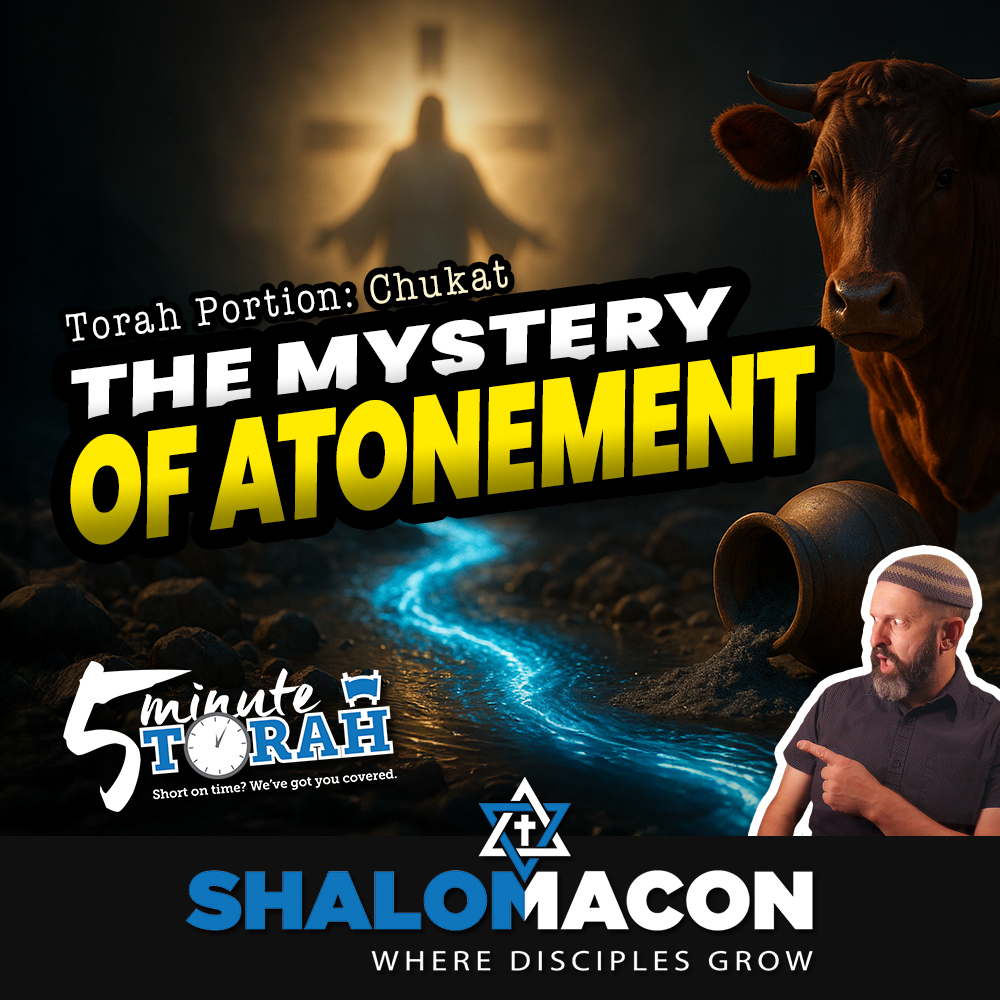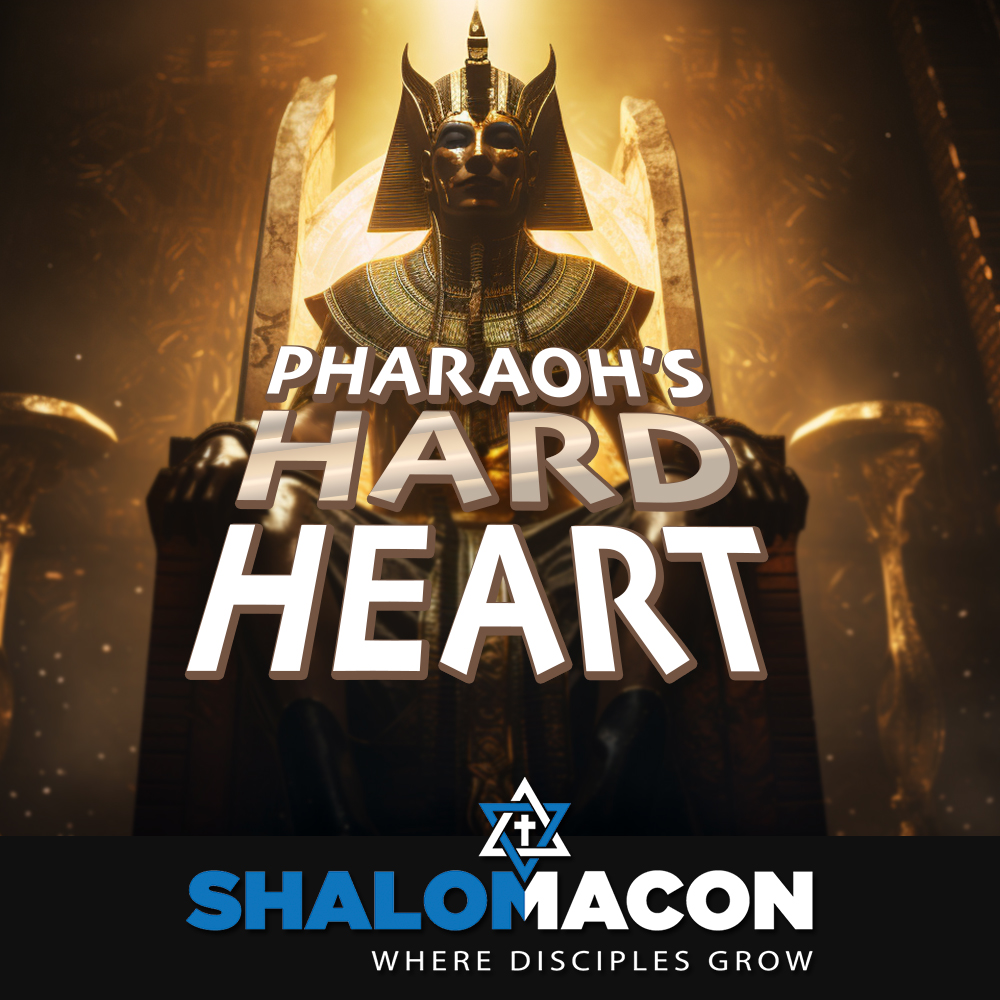Episode Transcript
[00:00:00] Why does the Torah, after prescribing the most baffling purification rite in history, the red heifer, immediately tell us of Miriam's death? What if this isn't just a random Bible dump, but a radical clue to God's true logic? Rabbinic sources teach us that just as the ashes of the red heifer atone, so too does the death of the righteous. And if a mere prophet's passing brings atonement, imagine the universal impact of the Messiah's sacrifice.
[00:00:27] Join me to discover why atonement hinges not on the ritual procedure alone, but on the life and the death of one who stands as collateral for us all in this week's five minute Torah Shalom and blessings from Shalom Macon, the place where disciples of Yeshua learn, connect and grow. I'm Darren, and before I get into the five minutes of my five minute Torah commentary, let's cover a few quick facts about this week's tonight Torah portion. This week we're studying the 39th portion, the portion of Hukkat numbers 19 1, 22 1. And here are the three things that you need to know about it. Number one Para Adumah, purification and Defilement. This week's Torah portion introduces the ritual of the Para aduma, the red heifer. It's one of the most mysterious and paradoxical commandments in the Torah. The perfectly red unblemished cow is slaughtered and burned and its ashes are mixed with water to create the the waters of purification. This mixture was used to cleanse individuals from severe forms of tuma ritual impurity, especially ritual impurity caused by contact with the dead. Strangely, those involved in preparing these waters became impure in the process. The commandment leaves us grappling to understand our human limitations and understanding God's ways, especially when it comes to holiness. Number two Striking the rock. Disobedience and Consequence One of the most puzzling and tragic moments in Moses leadership happens in this week's Torah portion. When the Israelites once again cry out for water. God tells Moses to speak to the rock and it will give forth water. But instead, Moses strikes it with his staff not once, but twice. Water flows, but the act is seen as a serious breach of trust. As a result, God declares that Moses will not lead the people into the promised land. And although the text leaves many questions unanswered, this moment reveals how great a responsibilities leaders bear and how even minor disobedience can bring lasting consequences.
[00:02:32] Number three Nahash Nechoshet, the Serpent and the Sun. As the children of Israel continue their journey, they once again complain, but this time against Moses and God. In response, God sends fiery serpents and many people die. When the people repent, God tells Moses to make a nechash nechoshet, a bronze serpent, and lift it up on a pole. Anyone bitten could look at it and live. This strange act becomes a test of faith and obedience. Much later, Yeshua references this event when speaking with Nicodemus, saying, just as Moses lifted up the serpent, so must the Son of Man be lifted up. Indeed, when he was lifted up on the cross, his death and resurrection became a source of life for all who would trust in him. Are you a disciple of Yeshua? There are a lot of people who say they are, but when it comes down to it, they really don't even know what it means to be a disciple. Why? Because discipleship is a concept unique to Judaism. It's an intimate relationship between a rabbi and his student. Yeshua called 12 men to be in his inner circle of discipleship, and those 12 men changed the world. What did they know about being a disciple that we don't? I wrestled with this question when I wrote my book, the Four Responsibilities of a Disciple. There were a ton of books already written on how to make disciples, but I wanted to know what it meant to be a disciple, because it seems that all of these disciples that were being made in our day really weren't having an impact on the world around them like they should. I found out that there were four responsibilities every disciple should know and that when implemented, living out these four responsibilities has the potential to to change the world. If you want to know what it means to be a true disciple of our master Yeshua, then check out my book, the Four Responsibilities of a Disciple, using the link below. This week's Torah commentary is called Collateral for Atonement and comes from my book, Five Minute Torah, Volume 3. The entire first chapter of the portion of Chuchat is concerned with the ashes of the red heifer. As we've seen in previous versions of the Five Minute Torah, the Torah's instructions about the ashes of the red heifer provide more questions than answers. For first, this entire ritual seems illogical. Why in the world would the ashes of a cow be used for purification? Second, the process is counterintuitive. Why do the ashes of the red heifer make a ritually unclean person clean and a ritually clean person unclean? But in our present commentary, we want to ask another question. Why are the laws of the red heifer immediately followed by the news of Miriam's death from a Superficial Reading Sometimes the Torah can seem like a hodgepodge of information dumped together with no logical organization. As we mentioned, our present Torah portion begins with the laws governing the ashes of the red heifer and is followed by the death of Miriam. This is followed by the incident regarding the waters of Medebah, then the death of Aaron. There doesn't seem to be a logical progression from one subject to the next. It's a little history mixed with various laws. However, if we take a deeper look, we'll see the divine inspiration of the Torah's logic. Rashi, the 11th century French rabbi and preeminent Torah scholar, takes note of the specific order of details the Torah gives us in this Torah portion. Since we read about the death of Miriam immediately following the instructions regarding the red heifer, Rashi believes there is something significant about this order and that these two topics are connected. His commentary may sound surprising. Rashi says that just as the ashes of the red heifer bring atonement, so too does the death of the righteous. He pulls his observation from both the Talmud and the Midrash and the Talmud. Rabbi Ami from the third century poses this exact same question along with the same conclusion. Rabbi Ami said, why was the Torah portion that describes the death of Miriam juxtaposed to the portion dealing with the red heifer? To tell you, just as the red heifer atones for sin, so too the death of the righteous atones. This is in moed katan 28A. The midrash takes this concept a step further and makes a connection between the death of Aaron's sons and the atonement of Yom Kippur. The Day of Atonement the sons of Aaron died on the first of Nisan in the Spring. Why then is their death mentioned in connection with the day of atonement in the Fall? It must be to teach that as the day of atonement affects atonement, the so the death of the righteous affects atonement. This is from Leviticus Rabba 20:12. Both of these commentaries may come as a shock to readers who are not familiar with rabbinic thought. However, these concepts are the keys to unlocking the power of Yeshua's atonement on our behalf. Rabbi Ami's comment in the Talmud sets the precedent that the death of a righteous person has the ability to bring with it atonement. If this is the case, how much more so would the death of a completely righteous person? In other words, Yeshua have the ability to atone for the entire world? The Midrash's view of the death of Aaron's sons is very similar to Yeshua's death. Like Aaron's sons, Yeshua died in the spring, specifically at Passover. Many people have connected him to the Passover lamb, but the Passover lamb wasn't sacrificed for atonement. Therefore, just as the Midrash connects the death of Aaron's sons to Yom Kippur, and we tend to connect Yeshua's atoning death with it as well, rather than Passover, Exodus Rabba has a very interesting connection that ties these concepts together. In a lengthy commentary of Exodus 26:15, the Midrash asserts, based on the grammar of the verse, that the tabernacle would serve as a collateral for Israel. This means that if ever Israel would forsake their covenant, God would take the tabernacle from them as payment for for their sins. But what if, asks the Midrash, there is no tabernacle to take when Israel strays from the covenant? It answers by saying, the Holy One, blessed be he, replied, I will then take one of their righteous men and retain him as collateral on their behalf in order that I may grant them atonement for all their sins. Exodus Rabba 35:4 Yeshua, the completely righteous Son of God, not only atones for our sin as the red heifer. Not only is the death of Miriam not only as the death of Aaron's sons and Yom Kippur, but also as the one whom God would take as collateral so that atonement could be made on our behalf to absolve us from all our sins. Let's guard this truth within our hearts and live each day taking advantage of that redemption he gave to us, not wasting away our days, but making the most of them so that his sacrifice will not be in vain. We all have to endure tests and trials to various degrees and are they an attempt to destroy us or is there a greater purpose they serve? How are we supposed to stay focused on the spiritual side of life when things are falling apart around us? If you want to know the purpose of trials and how to navigate them successfully, then you'll want to check out my three part series called Eye on the Prize. Just click on the link right here to get started.



